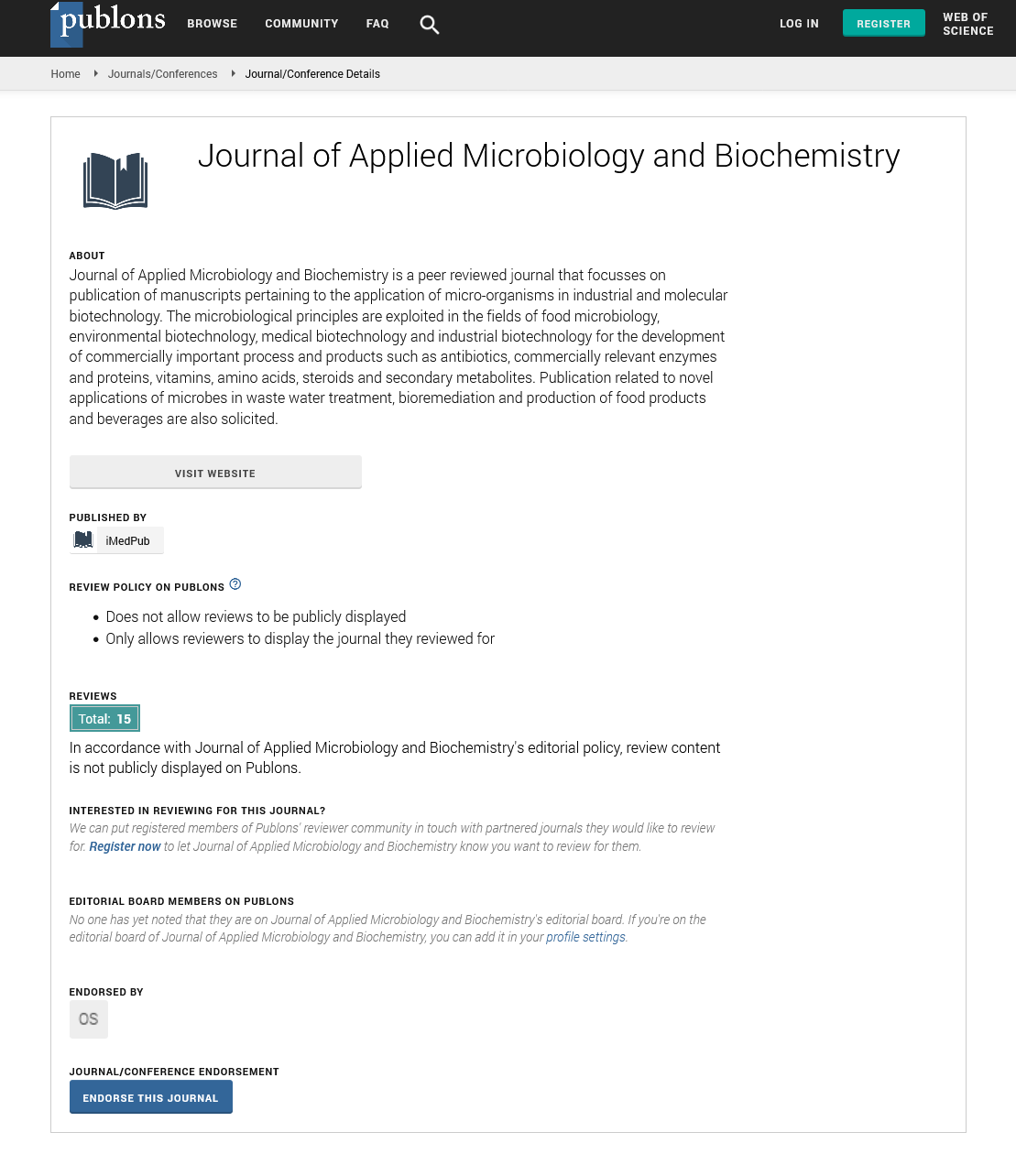ISSN : ISSN: 2576-1412
Journal of Applied Microbiology and Biochemistry
Abstract
Mechanisms of Nucleoside Analogs and their Therapeutic uses in Viral Infections
Nucleoside analogs are among the most potent and widely used agents in Ã?nÃ?à ÂÃ?à ÂÃ?Ã?à ¯ therapy. These ÃÂÃ?nÃ?à ?Ã?Ã?à Âc compounds mimic naturally occurring nucleosides, the building blocks of nucleic acids, but with structural mà ½Ã?à Âèà ÂcÃ?Ã?à Âà ½nàthat disrupt viral Ã?Ã?Ã?à ¯à ÂcÃ?Ã?à Âà ½nÃ? By Ã?Ã?Ã?à ÂÃ?Ã?à Ânà  cÃ?à ÂÃ?à ÂcÃ?à ¯ processes in viral life cycles, nucleoside analogs have Ã?Ã?Ã?à ½à ¯ÃµÃ?à Âà ½nà ÂÃ?Ã?Ã? the treatment of a variety of viral à ÂnèÃ?cÃ?à Âà ½nÃÂÃ? including HIV, à ?Ã?Ã?Ã?Ã?à ÂÃ?à ÂàB and C and herpesviruses. This Ã?Ã?Ã?à Âcà ¯Ã? describes the mechanisms by which nucleoside analogs inhibit viral Ã?Ã?Ã?à ¯à ÂcÃ?Ã?à Âà ½nÃ? their Ã?à ?Ã?Ã?Ã?Ã?Ã?õÃ?à Âc Ã?Ã?Ã?à ¯à ÂcÃ?Ã?à Âà ½nàand the challenges associated with their use. The primary mechanism of Ã?cÃ?à Âà ½n for nucleoside analogs is their ability to interfere with viral Ã?Ã?Ã?à ¯à ÂcÃ?Ã?à Âà ½nÃ? Once administered, these compounds are taken up by cells and phosphorylated by cellular or viral kinases to their Ã?cÃ?à ÂÃ?Ã? triphosphate forms. In this Ã?cÃ?à ÂÃ?Ã?Ã?Ã?Ã? state, nucleoside analogs are incorporated into the viral genome during Ã?Ã?Ã?à ¯à ÂcÃ?Ã?à Âà ½nÃ? leading to chain Ã?Ã?Ã?mà ÂnÃ?Ã?à Âà ½n or faulty Ã?Ã?Ã?à ¯à ÂcÃ?Ã?à Âà ½n processes. Many nucleoside analogs lack a 3'- hydroxyl group, which is need for forming the phosphodiester bond required for Ã?à ¯à ½nà ÂÃ?Ã?à Ânà  DNA or RNA strands. When these analogs are incorporated into the growing nucleic acid chain, Ã?Ã?Ã?à ¯à ÂcÃ?Ã?à Âà ½n halts. For example, zidovudine (AZT), a key Ã?nÃ?à ÂÃ?Ã?Ã?Ã?à ½Ã?à ÂÃ?Ã?à ¯ drug, disrupts HIV Ã?Ã?Ã?à ¯à ÂcÃ?Ã?à Âà ½n through this mechanism. Some nucleoside analogs introduce mõÃ?Ã?Ã?à Âà ½nàinto the viral genome, leading to nonviable or Ã?Ã?ÃÂèõncÃ?à Âà ½nÃ?à ¯ progeny viruses. Ribavirin, used in Ã?Ã?Ã?Ã?Ã?à Ânà  à ?Ã?Ã?Ã?Ã?à ÂÃ?à ÂàC, induces lethal mutagenesis in viral RNA.Nucleoside analogs can also act as cà ½mÃ?Ã?Ã?à ÂÃ?à ÂÃ?Ã? inhibitors of viral polymerases, enzymes important for genome Ã?Ã?Ã?à ¯à ÂcÃ?Ã?à Âà ½nÃ? Sofosbuvir, an analog used in à ?Ã?Ã?Ã?Ã?à ÂÃ?à ÂàC treatment, targets the viral RNA-dependent RNA polymerase, Ã?Ã?Ã?Ã?Ã?nÃ?à Ânà  viral RNA synthesis. The ÃÂÃ?à ¯Ã?cÃ?à ÂÃ?à ÂÃ?Ã? of nucleoside analogs stems from their Ã?Ã?Ã?èÃ?Ã?Ã?nÃ?à ÂÃ?à ¯ Ã?cÃ?à ÂÃ?Ã?Ã?à Âà ½n or à Âncà ½Ã?Ã?à ½Ã?Ã?Ã?à Âà ½n by viral enzymes rather than host enzymes. This ÃÂÃ?Ã?cà Âèà Âcà ÂÃ?Ã? reduces à ½Ã¨Ã¨Ã²Ã?Ã?Ã?à ÂÃ?Ã? Ã?èèÃ?cÃ?ÃÂÃ? making them highly Ã?èèÃ?cÃ?à ÂÃ?Ã? Ã?à ?Ã?Ã?Ã?Ã?Ã?õÃ?à Âc agents.
Author(s): Feng Duan
Abstract | PDF
Share This Article
Google Scholar citation report
Citations : 342
Journal of Applied Microbiology and Biochemistry received 342 citations as per Google Scholar report
Journal of Applied Microbiology and Biochemistry peer review process verified at publons
Abstracted/Indexed in
- Google Scholar
- China National Knowledge Infrastructure (CNKI)
- Cosmos IF
- Directory of Research Journal Indexing (DRJI)
- Publons
- Secret Search Engine Labs
Open Access Journals
- Aquaculture & Veterinary Science
- Chemistry & Chemical Sciences
- Clinical Sciences
- Engineering
- General Science
- Genetics & Molecular Biology
- Health Care & Nursing
- Immunology & Microbiology
- Materials Science
- Mathematics & Physics
- Medical Sciences
- Neurology & Psychiatry
- Oncology & Cancer Science
- Pharmaceutical Sciences
